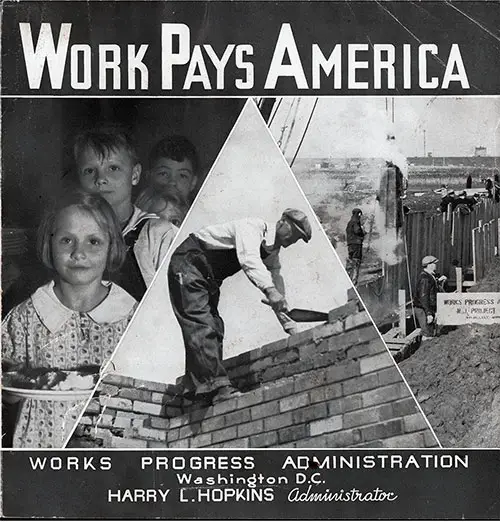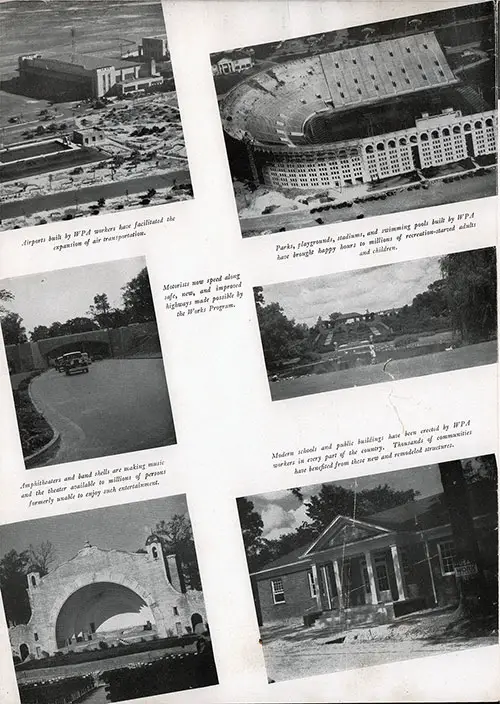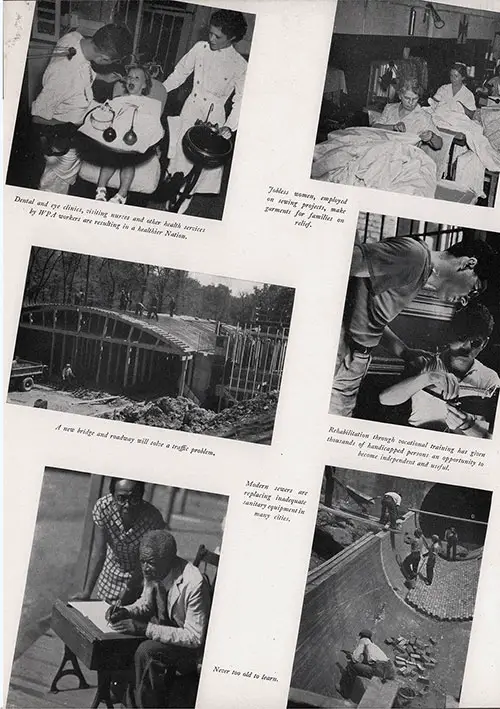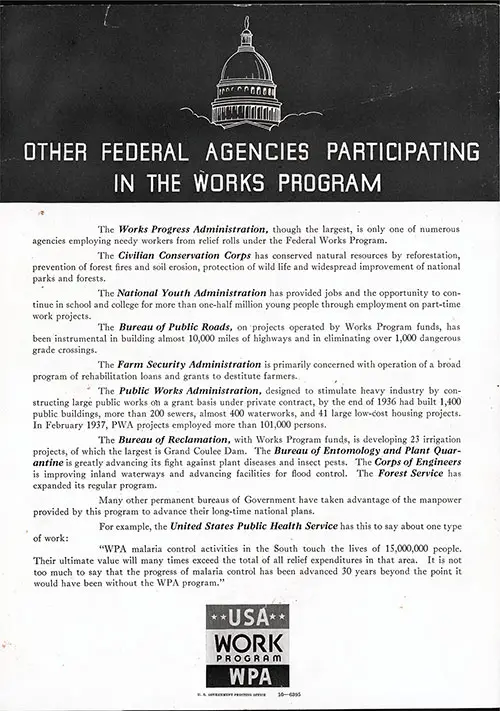🛠️ Building America: How WPA Jobs Transformed the Nation (1937)
📌 Explore the lasting impact of the Works Progress Administration (WPA) with hard data, visuals, and firsthand accounts from "Work Pays America" (1937). Learn how millions of unemployed Americans built roads, schools, parks, and infrastructure that still shape the U.S. today. A must-read for teachers, students, historians, and policy analysts.

Artwork from Front Cover of Works Pays America, a Flyer from the Works Progress Administration, 1937. | GGA Image ID # 22230a51e1
"Work Pays America" (1937)
📜 A Dynamic Snapshot of WPA's Achievements and Economic Impact 📜
"Work Pays America" (1937) serves as a powerful visual and written representation of the tangible successes of the Works Progress Administration (WPA). With a blend of compelling statistics, vivid imagery, and persuasive language, the document aims to highlight the WPA’s broad impact on infrastructure, employment, and public well-being.
This publication is particularly valuable for teachers, students, genealogists, and historians seeking a direct glimpse into the New Deal's job creation efforts and their lasting effects on American communities.
THE FEDERAL WORKS PROGRAM, which took millions of needy unemployed men and women from the destructive idleness of the relief rolls and put them to work at useful public tasks, has been in operation nearly 2 years.
Millions of Americans who never felt the pinch of unemployment are now using roads and streets, parks and airports, stadiums and swimming pools, water and sewer systems, hospitals and libraries and schools which would not exist today except for this program.
Each of these civic improvements represents an increase in our national wealth, and in the day-to-day pleasure or comfort of many people. They represent savings in local taxes .
This brief report summarizes the vast and varied accomplishments of those jobless and needy workers who, but for this program, would have created nothing.
WORKS PROGRESS ADMINISTRATION
Washington D.C.
HARRY HOPKINS Administrator
ACCOMPLISHMENTS

WPA Projects Including Airports, Parks, Playgrounds, Stadiums, and Swimming Pools, Highways, Amphitheaters, and Band Shells, and Modern Schools and Public Buildings. Works Pays America, a Flyer from the Works Progress Administration, 1937. | GGA Image ID # 222345a3ae
Description of Above Images, Left to Right, Top to Bottom:
- Airports built by W.P.A. workers have faciltated the expansion of air transportation.
- Parks, Playgrounds, stadiums, and swimming pools built by W.P.A. have brought happy hours to millions of recreation-starved adults and children. (Image of Stadium and below, Image of Park)
- Motorists now speed along safe, new, and improved highways made possible by the Works Program.
- Amphitheaters and band shells are making music and the theater available to millions of persons formerly unable to enjoy such entertainment.
- Modern Schools and public buildings have been created by W.P.A. workers in every part of the country. Thousands of communities have benefited from these new and remodeled structures.
When people are to be employed by the million, their range of work-ability or work-experience covers hundreds of occupations. It is desirable to employ each at the task he does best, or at the task most likely to enable him to hold a private job whenever he can return to one. Here's how these occupational groups have been employed (in thousands of communities) by the WPA:
Construction work employs laborers, engineers, architects, draftsmen, mechanics, truck drivers, machine operators, building trades workers, etc. Four-fifths of all WPA workers can perform some phase of construction work, and by far the largest single group of these is unskilled labor. Road and conservation work provides such jobs in rural areas.
WPA construction workers have built, repaired, renovated, extended, or modernized -- enough farm-to-market roads to reach five times around the earth, including:
- 21,000 bridges
- 8,300 schools
- 5,000 other public buildings
- 1,000 hospitals or institutions
- 252 airports
- 4,500 miles of sewers
- 1,200 disposal plants
- 2,300 miles of water mains
- 1,500 parks
- 3,000 athletic fields
- 395 swimming pools and golf courses
- 4,000 tennis courts and many other facilities.
They have planted 4,700,000 trees, drained 528,000 acres of malaria swamps, stocked 23,000,000 fish and 28,000 game animals and fowl, built or renovated 2,300 miles of stream beds, 375 miles of levees, 650 miles of river banks.
Many other workers are trained in the clerical, professional, and technical fields, or in the arts, or (such as young people of the depression era) lacking in skill or experience. How are they being used?

WPA Projects Including Dental and Eye Clincs, Sewing Projects, Bridges, Vocational Training, Education, and Sanitary Equipment. Works Pays America, a Flyer from the Works Progress Administration, 1937. | GGA Image ID # 151a6bc72f
Description of Above Images, Left to Right, Top to Bottom:
- Dental and eye clinics, visiting nurses and other health services by W.P.A. workers are resulting in a healthier Nation.
- Jobless women, employed on sewing projects, make garments for families on relief.
- A new bridge and roadway will solve a traffic problem.
- Rehabilitation through vocational training has given thousands of handicapped persona an opportunity to become independent and useful.
- Never too old to learn via the WPA
- Modern sewers are replacing inadequate sanitary equipment in many cities.
Doctors, nurses, and dentists have provided 9,100,000 visits, examinations, or treatments to people unable to pay for them. Qualified workers have inoculated many thousands of children against contagions, campaigned against infantile paralysis and trachoma, promoted rural sanitation, aided the blind and the handicapped. Such projects are sponsored and supervised by State and local public health authorities.
Librarians and clerks run 2,000 "traveling libraries" in remote areas, have repaired 11,000,000 books for schools and libraries. Teachers in adult classes have reduced illiteracy in America 16 percent.
Women of the WPA have produced 60,000,000 articles of clothing, bedding, etc., for those in need or for public institutions. They have prepared and served 80,000,000 hot school lunches for hungry children.
WPA artists have produced 1,100 mural paintings for public buildings, musicians have played to aggregate audiences of 71,000,000, theater people have launched a renaissance in flesh-andblood drama, writers are preparing guidebooks to the whole nation.
All over America WPA clerical and professional people are giving long-needed public service: They are checking traffic to save lives and guide paving programs. They are revising tax records to spot evaders.
The multitude of small unpaid Federal taxes uncovered thus far total up to the impressive sum of $25,000,000. One State mineral-resource survey discovered a $350,000,000 deposit of Glauber's salt.
A check of the New York City water system corralled $209,000 a year in new revenue. Hundreds of surveys are developing knowledge that will result in human savings, or actual dollars-and-cents economies for the future. And the bulk of the work is being done by people who can find no other work to do.
FACTS ABOUT THE WPA
The Nation never had enough roads and streets, schools, parks, airports, sewer, and water systems. It never had enough conservation work to protect natural resources. It never had enough libraries or books, health services or educational opportunities. A host of Americans do not have adequate food or clothing.
During the depression, local communities had less and less money with which to build, expand, or repair public facilities and services, yet the population (and therefore the need) grew steadily.
Millions of people needed work who could help meet these shortages. They included doctors and nurses, mechanics, clerks, teachers, building trades workers, scientists, dietitians, housewives, unskilled laborers, and workers in hundreds of other occupations. Their training and energy were unused because they could not find jobs.
The Federal Government appealed to local officials everywhere to plan and put forward essential civic improvements and services which could employ their own local unemployed who were certified by local agencies as in need.
Local officials rallied to this appeal, carefully planning widely varied, useful projects in their communities to meet the wide variety of skill and experience among the unemployed. The WPA paid the wages of the workers, local money paid most of the cost of materials.
The result was essentially a localized program. Each community got what its officials wanted and requested. The local money they contributed (averaging 16 percent of all project costs) was evidence of the usefulness of the projects. About 85 cents out of every Federal dollar went directly into pay envelopes to be spent quickly by security workers in the channels of local business.
Literally thousands of local officials, of many political faiths, have praised the workmanship on these projects. Hundreds of thousands of WPA workers have returned to private industry, able to hold their old jobs because the Works Program kept them from going rusty and losing hope. More are returning daily, as rapidly as new jobs are available. The WPA has helped many business men to remain in business, owing to the great amount of materials used on these new projects.
OTHER FEDERAL AGENCIES PARTICIPATING IN THE WORKS PROGRAM

Other Federal Agencies Participating in the Works Program: USA Work Program WPA, U.S. Government Printing Office No. 16-6395. Works Pays America, a Flyer from the Works Progress Administration, 1937. | GGA Image ID # 1519db8c80
The Works Progress Administration, though the largest, is only one of numerous agencies employing needy workers from relief rolls under the Federal Works Program.
- The Civilian Conservation Corps has conserved natural resources by reforestation, prevention of forest fires and soil erosion, protection of wild life and widespread improvement of national parks and forests.
- The National Youth Administration has provided jobs and the opportunity to continue in school and college for more than one-half million young people through employment on part-time work projects.
- The Bureau of Public Roads, on projects operated by Works Program funds, has been instrumental in building almost 10,000 miles of highways and in eliminating over 1,000 dangerous grade crossings.
- The Farm Security Administration is primarily concerned with operation of a broad program of rehabilitation loans and grants to destitute farmers.
- The Public Works Administration, designed to stimulate heavy industry by constructing large public works oh a grant basis under private contract, by the end of 1936 had built 1,400 public buildings, more than 200 sewers, almost 400 waterworks, and 41 large low-lost housing projects. In February 1937, PWA projects employed more than 101,000 persons.
- The Bureau of Reclamation, with Works Program funds, is developing 23 irrigation projects, of which the largest is Grand Coulee Dam. The Bureau of Entomology and Plant Quarantine is greatly advancing its fight against plant diseases and insect pests. The Corps of Engineers is improving inland waterways and advancing facilities for flood control. The Forest Service has expanded its regular program.
Many other permanent bureaus of Government have taken advantage of the manpower provided by this program to advance their long-time national plans.
For example, the United States Public Health Service has this to say about one type of work:
"WPA malaria control activities in the South touch the lives of 15,000,000 people. Their ultimate value will many times exceed the total of all relief expenditures in that area. It is not too much to say that the progress of malaria control has been advanced 30 years beyond the point it would have been without the WPA program."
Relevance & Importance
📜 A Window into the New Deal’s Impact
✔ A Primary Source for Understanding the WPA’s Accomplishments
This 1937 flyer documents the first two years of the WPA’s operation, offering a firsthand account of how the agency transformed the nation.
✔ A Historical Record of Public Works
The report provides hard numbers on infrastructure projects, demonstrating how WPA funding was applied to build roads, parks, schools, and utilities across the country.
✔ A Snapshot of Depression-Era Economic Policy
The WPA was not just about job creation; it was about investing in long-term public goods. This document illustrates how these projects benefited everyday Americans.
📌 For researchers and educators, this report is an essential reference for studying Roosevelt’s New Deal, labor policies, and economic recovery efforts during the Great Depression.
::::: Most Engaging Content :::::
📌 The Transformative Power of the WPA
✔ Opening Statement: "Work Pays America"
The title itself is a play on words, reinforcing the idea that investing in jobs yields economic and social returns.
The introduction sets the tone: millions of Americans directly benefited from the WPA, not only through employment but also through public projects that enriched daily life.
Emphasizes that WPA projects were not "handouts," but rather investments in local and national wealth.
📌 This introduction is especially valuable for students studying the rhetoric of the New Deal and the justification for government intervention in economic crises.
📌 Hard Numbers: The WPA’s Tangible Achievements
✔ Massive Infrastructure Expansion
21,000 bridges
8,300 schools
5,000 public buildings
1,000 hospitals
252 airports
4,500 miles of sewers
1,500 parks and 3,000 athletic fields
📌 These statistics are invaluable for historians analyzing the scale of government intervention during the Depression and how it shaped America’s infrastructure.
✔ Public Health & Education
🔹 9.1 million medical visits provided to those unable to afford care.
🔹 16% reduction in illiteracy, thanks to WPA teachers educating adults.
🔹 80 million hot school lunches served to undernourished children.
📌 This section is particularly useful for educators teaching about the social aspects of the WPA beyond infrastructure.
✔ Arts & Culture Contributions
🔹 1,100 murals painted in public buildings.
🔹 71 million people attended WPA-sponsored theater performances.
🔹 Federal Writers’ Project created state guidebooks, preserving American history and folklore.
📌 For genealogists, artists, and literature historians, this provides crucial insight into the WPA’s cultural impact.
📌 Social & Economic Justification for WPA Work
✔ A Localized, Community-Driven Approach
🔹 The document makes it clear that the WPA worked with local governments to fund projects.
🔹 85% of WPA funds went directly into workers’ paychecks, which were then reinvested into local economies.
🔹 Local governments had to contribute 16% of the cost, demonstrating shared responsibility in public projects.
📌 This section is great for political science and economic studies on how public-private partnerships functioned during the Great Depression.
✔ Comparison to Other Federal Work Programs
This report places the WPA in the context of other New Deal agencies, such as:
🔹 Civilian Conservation Corps (CCC) – focused on environmental and reforestation projects.
🔹 Public Works Administration (PWA) – concentrated on large-scale, heavy construction projects.
🔹 National Youth Administration (NYA) – provided part-time jobs for students.
📌 Understanding these distinctions helps historians and students see how different agencies targeted different aspects of unemployment relief.
Noteworthy Images & Their Significance
📸 Artwork from Front Cover of "Work Pays America"
🔹 Serves as a visual representation of government optimism, emphasizing progress and productivity over relief or charity.
📸 WPA Projects: Airports, Parks, Schools, Roads, and Public Buildings
🔹 A collage of infrastructure projects demonstrates the massive scope of WPA work across various sectors.
📸 Images of Health Clinics, Sewing Projects, and Education Programs
🔹 These highlight the WPA’s broader social mission, beyond just physical labor.
📌 These images are perfect for presentations, museum exhibits, and classroom discussions about the New Deal’s visual propaganda.
Who Would Benefit from This Document?
✅ Teachers & Students – Provides real-world statistics and visuals for classroom discussions on the Great Depression.
✅ Historians & Economists – A data-rich snapshot of government spending and job creation policies.
✅ Genealogists – Helps trace family members who may have worked on WPA projects.
✅ Policy Analysts – A case study in federal job creation and its effects on local economies.
Perceived Bias & Perspective
📌 Potential Bias
🔹 As an official government publication, this document presents the WPA in an overwhelmingly positive light.
🔹 Fails to address criticisms that WPA projects sometimes displaced private-sector jobs.
🔹 Downplays racial and gender discrimination—while WPA projects employed many African Americans and women, they were often given lower-paying jobs.
📌 For a balanced perspective, researchers should pair this with WPA critiques from newspapers or congressional records.
Final Thoughts: A Must-Read WPA Document
"Work Pays America" (1937) is a compelling defense of the WPA, packed with statistics, images, and persuasive arguments for continued government investment in employment programs.
While biased in favor of the Roosevelt administration, it remains an indispensable primary source for understanding how public works projects helped pull America out of the Great Depression.
For students, historians, and researchers, this document is a crucial tool for analyzing the political, social, and economic legacy of the WPA. 🏗️📚💡
